Balbharti Maharashtra State Board Class 9 History Solutions Chapter 6 Empowerment of Women and Other Weaker Sections Notes, Textbook Exercise Important Questions and Answers.
Maharashtra State Board Class 9 History Solutions Chapter 6 Empowerment of Women and Other Weaker Sections
Class 9 History Chapter 6 Empowerment of Women and Other Weaker Sections Textbook Questions and Answers
1. Complete the statements by choosing the proper option:
Question 1.
In 1992, a movement against drinking alcohol was started in _________.
(a) Maharashtra
(b) Gujarat
(c) Andhra Pradesh
(d) Uttarakhand
Answer:
(c) Andhra Pradesh
![]()
Question 2.
In 1975, the government of India formed the Committee on the status of women under chairmanship of ______.
(a) Dr Phulrenu Guha
(b) Uma Bharati
(c) Vasundhara Raje
(d) Pramila Dandavate
Answer:
(a) Dr Phulrenu Guha
2.B Identify the wrong pair and rewrite the corrected one:
Question 1.
(i) Saudamini Rao – Stree-Mukti Andolan Samiti
(ii) Vidya Bal – Nari Samata Manch
(iii) Pramila Dandavate – Mahila Dakshata Samiti
(iv) Jyoti Mhapsekar – Committee on the Status of Women
Answer:
Wrong Pair : Jyoti Mhapsekar – Committee on the Status of Women
3. Make a concept chart:
Question 1.
Laws related to women:
Answer:
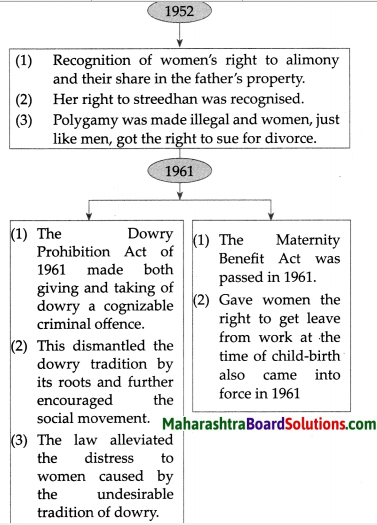
![]()
4. Explain the concepts:
Question 1.
Alimony
Answer:
(i) A fixed amount paid to a married woman for her upkeep by the husband who has divorced her, is called alimony.
(ii) The law enacted in 1952, recognizes women’s right to alimony and their share in the father’s property. Her right to Sreedharan was recognized.
Question 2.
Minority
Answer:
(i) In any society, a group of people of a particular religion, language or race who are few in number are termed as a minority.
(ii) As there are various religions, sects, and languages in our country, we see great cultural diversity. There is variation in cultural traditions, too.
5. Explain the following statements with reasons:
Question 1.
The evolution of the women’s liberation movement.
Answer:
(i) The United Nations had declared 1975 as the International Women’s Year.
(ii) In 1975, the government of India constituted the Committee on the Status of Women and appointed Dr Phulrenu Guha as its Chairman.
(iii) A comprehensive survey was conducted on several issues such as the social position of women, their status, the consequences of the constitutional provisions made for women as also education of women and its percentage, their progress due to education, difficulties faced by working women, the position of women with respect to work /livelihood, their wages , the female-male ratio, birth and mortality rate and the role of women.
(iv) Taking into consideration this entire background, a State-wide conference for women was held in 1975 organised by the Stree-mukti Sangharsha Samiti. Women from all walks of life / regions participated in it.
(v) The Samiti published its manifesto in 1978. The policy of a struggle against discrimination on the basis of gender, caste and vama was adopted.
(vi) In 1977, groups like the Streemukti Andolan Samiti established by Soudamini Rao in Pune, Bayaja a fortnightly, as also Stree Uvach, Maitrin and Stree Anyayavirodhi Manch in Aurangabad, Mahila Dakshata Samiti in Kolhapur, Mahila Hakka in Nashik and Nari Prabodhan Manch in Latur were formed.
(vii) Anti-dowry protection committees were formed all over Maharashtra. A conference to protest against oppression of women was organised in Dhule city.
Question 2.
The Prohibition of Dowry (Amendment) Act was enacted in 1984.
Answer:
(i) Even after the enactment of the anti-dowry law, incidents like ‘Woman bums to death as sari pallu catches fire while cooking’ and ‘Woman slips into well while washing clothes, drowns and dies’ continued to be reported.
(ii) Investigations still revealed dowry to be the most frequent cause of such deaths.
(iii) The role of the police, the administration and judiciary were highlighted. This created greater awareness.
(iv) As a result, the Dowry Prohibition (Amendment) Act came into force in 1984.
Question 3.
The practice of untouchability was banned by law.
Answer:
(i) In the post-independence period, our Constitution adopted the values of freedom, equality, fraternity and social justice.
(ii) In accordance with this, the practice of untouchability was banned by law.
(iii) Untouchability was removed by the 17th paragraph of the Constitution and this class was included in the Scheduled Castes.
Question 4.
The Constitution gives cultural and educational rights to minorities.
Answer:
(i) In any society, a group of people of a particular religion, language or race who are few in number are termed a minority.
(ii) As there are various religions, sects and languages in our country, we see great cultural diversity. There is variation in cultural traditions, too.
(iii) In order to preserve their cultural traditions and develop their own language, the Constitution gives the citizens certain educational and cultural rights.
(iv) Minorities have the right to protect and conserve their language, culture and traditions.
(v) For this purpose they have the right to set up separate educational institutions.
![]()
6. Answer the following questions in 25 to 30 words:
Question 1.
Describe the Chipko movement.
Answer:
(i) The show of constructive woman power was seen during the Chipko movement in 1973.
(ii) Trees from the forests in the foothills of the Himalayas were to be cut down for commercial purposes.
(iii) Chandiprasad Bhat and Sunderlal Bahuguna had started a movement to prevent this.
(iv) Women followed the strategy of holding hands and encircling each tree.
(v) As their method consisted of protecting the tree by embracing it, the movement came to be known as the Chipko movement.
(vi) Women took part in it in large numbers. Women had a big role to play in the agricultural economy of this region.
(vii) Gaura Devi was the activist who created this awareness among the women with the help of Sudesha Devi and Bachani Devi.
Question 2.
Write a note on the Protection of Human Rights Act.
Answer:
(i) In 1993, the Protection of Human Rights Act law was enacted to prevent injustice to men and women.
(ii) The National Human Rights Commission was also formed for this purpose.
(iii) In some States, the State Human Rights Commission was also formed on the same lines.
(iv) This law which deals with collective oppression, the social conditions of divorced women, women and secure work places, played an effective role in mitigating injustices to women.
7. Answer the following question in detail:
Question 1.
Explain with examples how the united strength of women can bring about constructive changes in various fields.
Answer:
(i) Women, who have to face the brunt of scarcity of supplies and rising prices, gave a show of their strength as an organised entity in 1972.
(ii) Under the leadership of the socialist leader Mrinal Gore, women in Mumbai participated in a demonstration which came to be known as the laatne morcha (the rolling pin demonstration).
(iii) Commodities like oil, ghee, rava, maida, would become scarce just as Diwali was near at hand. Kerosene had become very expensive.
(iv) Women came together brandishing their rolling pins and took part in the demonstration.
(v) This movement met with success and the public got a glimpse of the united power of women.
(vi) Another show of constructive woman power was seen during the Chipko movement in 1973. Gaura Devi was the activist who created awareness among the women with the help of Sudesha Devi and Bachani Devi.
(vii) In 1992, three youths of Dubuganta village of Nellore district in Andhra Pradesh drowned in a lake, in a state of inebriation, and died.
(viii) At this instance, the women of the village came together and forced the closure of arrack shops.
(ix) The movement spread to the entire State and the government had to adopt a strict policy against the sale of alcohol.
(x) On 4th September 1987, Roop Kanwar, a married woman, committed sati. She did not do this of her own free will; she was coerced into doing so. Committing sati, glorifying the practice of sati were all illegal acts.
(xi) The women activists and journalists, Meena Menon, Geeta Seshu, Sujata Anandan, Anu Joseph and Kalpana Sharma investigated the case. In 1998, the government passed the Sati (Prevention) Act with very stringent provisions.
Class 9 History Chapter 6 Empowerment of Women and Other Weaker Sections Additional Important Questions and Answers
Choose the correct option from the given options and rewrite the statements:
Question 1.
Under the leadership of the socialist leader ______ women in Mumbai participated in a demonstration which came to be known as the Laatne Morcha.
(a) GauraDevi
(b) Dr Phulrenu Guha
(c) Meena Menon
(d) Mrinal Gore
Answer:
(d) Mrinal Gore
Question 2.
Vinoba Bhave made use of women power in the _____.
(a) Bhoodan Movement
(b) Chipko Movement
(c) Laatne Morcha
(d) Anti-liquor movement
Answer:
(a) Bhoodan Movement
Question 3.
Women activists associated with the Chipko movement ________.
(a) Sucheta Kripalani, Nandini Satpathy and Jayalalitha
(b) Dr Phulrenu Guha, Uma Bharati and Vasundhara Raje
(c) Gaura Devi, Sudesha Devi and Bachani Devi
(d) Dr Phulrenu Guha, Meena Menon and Mrinal Gore
Answer:
(c) Gaura Devi, Sudesha Devi and Bachani Devi
![]()
Question 4.
The Chipko movement was started by ______.
(a) Chandiprasad Bhat and Sunderlal Bahuguna
(b) Sudesha Devi and Bachani Devi
(c) Vinoba Bhave and Mahatma Gandhi
(d) Meena Menon and Mrinal Gore
Answer:
(a) Chandiprasad Bhat and Sunderlal Bahuguna
Question 5.
The United Nations had declared as _____ the International Women’s Year.
(a) 1992
(b) 2000
(c) 1975
(d) 1988
Answer:
(c) 1975
Question 6.
A collection of songs called Streemuktichi Lalkari, a street play called Mulgi Jhaali Ho are written by ______.
(a) Vidya Bal
(b) Pramila Dandavate
(c) Sujata Anandan
(d) Jyoti Mhapsekar
Answer:
(d) Jyoti Mhapsekar
Question 7.
A State-wide conference for women was held in 1975 organised by the _______.
(a) Samajwadi Mahila Sabha.
(b) Stree-mukti Sangharsha Samiti.
(c) Nari Prabodhan Manch.
(d) Stree Anyayavirodhi Manch.
Answer:
(b) Stree-mukti Sangharsha Samiti.
Question 8.
Census is conducted in India every _______.
(a) 5 years
(b) 10 years
(c) 15 years
(d) 20 years
Answer:
(b) 10 years
Identify and write the wrong pair in the following sets:
Question 1.
(i) Vinoba Bhave – Bhoodan Movement
(ii) Chandiprasad Bhat and Sunderlal Bahuguna – Chipko movement
(iii) Dr Phulrenu Guha – Laatne Morcha
(iv) Shah Bano Begum – Right to alimony
Answer:
Wrong Pair: Dr Phulrenu Guha – Laatne Morcha
Question 2.
(i) Stree Anyayavirodhi Manch – Aurangabad
(ii) Mahila Dakshata Samiti – Pune
(iii) Mahila Hakka – Nashik
(iv) Nari Prabodhan Manch – Latur
Answer:
Wrong Pair : Mahila Dakshata Samiti – Pune
Question 3.
(i) Stree-mukti Andolan Samiti – Soudamini Rao
(ii) Mahila Dakshata Samiti – Phulrenu Guha
(iii) Milun Saryajani – Vidya Bal
(iv) Laatne Morcha – Mrinal Gore
Answer:
Wrong Pair: Mahila Dakshata Samiti – Phulrenu Guha
Question 4.
(i) Streemuktichi Lalkari – Collection of songs
(ii) Mulgi Jhaali Ho – Periodical
(iii) Bayaja – fortmighty
(iv) Sitama Katha – Story
Answer:
Wrong Pair : Mulgi Jhaali Ho – Periodical
![]()
Do as directed
Make a concept chart:
Question 1.
Roop Kanwar Sati Case.
Answer:
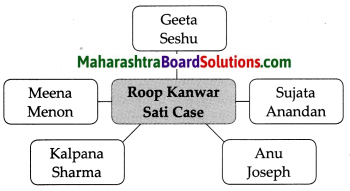
Question 2.
List at least five Women Chief Ministers in India:
Answer:
- Sucheta Kriplani (Uttar Pradesh)
- Nandini Satpathy (Odisha)
- Jayalalitha (Tamil Nadu)
- Mayawati (Uttar Pradesh)
- Vasundhara Raje (Rajasthan)
- Mamata Banerjee (West Bengal)
- Rabdi Devi (Bihar)
- Anandiben Patel (Gujarat)
- Sheila Dixit (Delhi)
- Mehbooba Mufti Sayeed (Jammu & Kashmir)
- Uma Bharati (Madhya Pradesh)
- Rajendra Kaur Bhattal (Punjab)
- Sushma Swaraj (Delhi)
- Shashikala Kakodkar (Goa)
- Sayeeda Anwar Taimur (Assam)
- Janaki Ramachandran (Tamil Nadu), are all women who have led their States as Chief Ministers.
Complete the following chart:
Question 1.
| Women | Contribution |
| Dr. Phulrenu Guha | …………………. |
| ……………… | Streemukti Andolan Samiti |
| Vidya Bal | ……………….. |
| ……………….. | Mahila Dakshata Samiti |
Answer:
| Women | Contribution |
| Dr. Phulrenu Guha | Chairman Committee on Status for Women |
| Soudamini Rao | Streemukti Andolan Samiti |
| Vidya Bal | Nari Samata Manch |
| Pramila Dandavate | Mahila Dakshata Samiti |
Write short notes on:
Question 1.
International Women’s Day
Answer:
(i) A demonstration was held in New York on 8 March 1857.
(ii) It was the first demonstration by working women and its demands were for fewer working hours, proper remuneration, provision of creches, etc.
(iii) On 8 March 1909 women went on strike for the very same demands. That is why, this day was declared as the Women’s Struggle Day at the Women’s Socialist International, a conference held in Denmark.
(iv) The year 1975 was observed as the International Women’s Year and in 1977, 8 March was declared as International Women’s Day by a resolution passed in the General Assembly of the United Nations.
(v) The three aspects of this programme were peace, development and equality between men and women.
Question 2.
Family Courts
Answer:
(i) Family courts were established to resolve conflicts arising out of differences within marriage and domestic problems as well as issues such as alimony, single parenthood, separation, care of children and ownership which are all related to the family situation.
(ii) These family courts give priority to mutual understanding over witnesses and evidence and to counsellors over lawyers.
(iii) Emphasis is on resolving issues quickly but justly.
![]()
Question 3.
Reservation for Women
Answer:
(i) The 73rd and 74th amendments to the Constitution provide for reservation of one-third of the seats for women in Gram Panchayats, Panchayat Samitis, Zilla Parishads, municipalities and municipal corporations as well as for the posts of Sarpanch, Chairman and Mayor.
(ii) Maharashtra and 15 other states have reserved 50% seats for women.
(iii) This provision provides women the opportunity to participate in the business of the community.
Question 4.
Scheduled Tribes
Answer:
(i) The Scheduled Tribes or Adivasis who live in remote parts of the country face several difficulties.
(ii) As they have lived far away from the progress made in modem times, they are economically and socially backward.
(iii) Even though their conditions have seen some improvement in recent times, they do not have any means of livelihood other than agriculture and forest produce.
(iv) Modem farming implements have not yet reached them. Hence, their income from agriculture is very small. Besides, their fields are on hillsides and not fertile.
(v) They are malnourished due to insufficient and poor quality of diet.
(vi) Adivasis in remote areas find it difficult to get medical attention in time. For all these reasons, there is a need to give special protection to Adivasis.
(vii) In the Indian Constitution, Adivasis have been enumerated as Scheduled Tribes. They are given representation in law boards, education, government service, etc.
Question 5.
8th March was declared as International Women’s Day.
Answer:
(i) A demonstration was held in New York on 8 March, 1857. It was the first demonstration by working women and its demands were for fewer working hours, proper remuneration, provision of creches, etc.
(ii) On 8 March 1909 women went on strike for the very same demands. That is why, this day was declared as the Women’s Struggle Day at the Women’s Socialist International, a conference held in Denmark.
(iii) The year 1975 was observed as the International Women’s Year and in 1977, 8 March was declared as International Women’s Day by a resolution passed in the General Assembly of the United Nations.
Question 6.
The ‘Muslim Women’s Act’ (Protection of rights on divorce) was passed by Parliament.
Answer:
(i) A fixed amount paid to a married woman for her upkeep by the husband who has divorced her, is called alimony.
(ii) In the case of Mohammad Ahmed Khan vs Shah Bano Begum, the Supreme Court gave the verdict that Shah Bano Begum had the right to alimony.
(iii) However, religious organisations protested vociferously against the verdict.
(iv) As a result, the ‘Muslim Women’s Act’ (Protection of rights on divorce) was passed by Parliament.
Question 7.
In 1998, the government passed the Sati (Prevention) Act with very stringent provisions.
Answer:
(i) On 4th September 1987, Roop Kanwar, a married woman, committed sati. She did not do this of her own free will; she was coerced into doing so.
(ii) Committing Sati, glorifying the practice of Sati were all illegal acts.
(iii) The women activists and journalists, Meena Menon, Geeta Seshu, Sujata Anandan, Anu Joseph and Kalpana Sharma investigated the case.
(iv) So in 1998, the government passed the Sati (Prevention) Act with very stringent provisions.
Read the passage and answer the questions:
Passage I
International Women’s year: The United Nations ! had declared 1975 as the International Women’s Year. The three aspects of this programme were peace, development and equality between men and women. In 1975, the government of India constituted the Committee on the Status of Women and appointed Dr Phulrenu Guha as its Chairman. A comprehensive survey was conducted of several issues such as the social position of women, their status, the consequences of the constitutional provisions made for Women as also education of women and its percentage, their progress due to education, difficulties faced by working women, the position of women with respect to work/livelihood, their wages (relative to men’s wages), the female-male ratio, birth and mortality rates and the role of women.
Taking into consideration this entire background, State-wide conference for women was held in 1975 organised by the stree-mukti Sangharsha Samiti. Women from all walks of life/regions participated in it. The Samiti published its manifesto in 1978. The Samiti published its manifesto discrimination on the basis of gender, caste and vama was adopted.
This gave rise to a collection of songs called Streemuktichi Lalkari, a street play called Mulgi Jhali Ho by Jyoti Mhapsekar and a periodical called Prerak Lalkari which became their mouthpiece and other such programmes. In 1977, groups like the Streemukti Andolan Samiti established by Soudamini Rao in Pune, Bayaja a fortnightly, as also Stree Uvach, Maitrin and Stree Anyayavirodhi Manch in Aurangabad, Mahila Dakshata Samiti in Kolhapur, Mahila Hakka in Nashik and Nari Prabodhan Manch in Latur were formed. Anti-dowry protection committees were formed all over Maharashtra. A conference to protest against oppression of women was organised in Dhule City.
![]()
Question 1.
Prepare a time line of the highlights mentioned in the passages.
Ans:
Timeline of the Highlights of the passage
- 1975 – UN declared International Women’s Day Committee on the Status of women was appointed.
- 1975 – Stree Mukti Sangharsha Samiti was organised.
- 1978 – Stree Mukti Sangharsha Samiti published a Manifesto
- 1977 – Stree Mukti Andolan Samiti was established by Soudamini Rao.
Question 2.
State the issues on which a survey was conducted by the committee on the status of women.
Ans:
The Committee on Status of Women appointed under the chairmanship of Dr. Phulrenu Guha made a comprehensive survey over several issues:
- Social position of women and their status.
- Consequences of the constitutional provision made for women.
- Education of women and it’s a percentage.
- Their progress due to education.
- Difficulties faced by working women with respect to work, livelihood, and wages.
- Female – male ratio.
- Birth and mortality rates.
- Role of women.
Question 3.
Name any two women who according to you managed to break the norms of the Indian Society and came up as icons of woman power.
Ans:
(i) Mrinal Gore
(ii) Gaura Devi
Passage II
Vidya Bal’s periodicals, Nari Samata Manch, and Milun Saryajani, as also the work ofthe Samajwadi Mahila Sabha and the Krantikari Mahila Sanghatana were of great help in dealling with women’s issues. The Employment Guarantee Scheme in Maharashtra also helped to empower women. Pramila Dandavate established the Mahila Dakshata Samiti in Delhi in 1976. Branches of the Samiti came up in the States of Andhra Pradesh, Tamil Nadu, Kerala, Odisha, Madhya Pradesh, Uttar Pradesh and Punjab. The Communist Party established the Akhil Bharatiya Janavadi Mahila Sanghatana in 1980. Efforts were made to start branches of this Organisation in all parts of India. The Sanghatana started a struggle against issues like dowry, female foeticide, domestic abuse, Research on women’s issues was undertaken at various levels. Women’s Studies Centres were started at the first women’s university, Mumbai and at Tata Institute of Social Sciences, Mumbai, Savitribai Phule Pune University and Shivaji University, Kolhapur. These Centres played an important role in critical analysis and in developing a vision on women’s issues.
Question 1.
State the role of Pramila Dandavate and Vidhya Bal in women’s upliftment.
Answer:
(i) Pramila Dandavate established Mahila Dakshata Samiti in Delhi in 1976.
(ii) Vidya Bal published periodicals like ’Nari Samata Manch’ and ‘Milun Saryajani’.
Question 2.
Where are the women’s study centers located in Maharashtra?
Answer:
Women study centers are located at:
- Shrimati Nathibai Damodar Thakersey Women’s University – Mumbai.
- Tata Institute of Social Sciences – Mumbai.
- Savitribai Phule University – Pune
- Shivaji University – Kolhapur.
Question 3.
Do you think International Beauty Pageants can help in creating awareness about women’s issues? why?
Answer:
Yes, International Beauty Pageants can help in creating global awareness on women’s issues world wide.
The participants in these events come from different cultures and backgrounds, they speak on many subjects affecting women which is covered by international media. Concerns pertaining to women’s political rights have been brought to the notice of the world through these pageants.
![]()
Answer the following questions in detail:
Question 1.
Explain, in detail, the Anti-liquor movement.
Answer:
(i) In 1992, in Andhra Pradesh, a movement was started against the drinking of alcohol. It received a good response in other States too.
(ii) When the head of the household dies an untimely death due to addiction to alcohol, the family faces a serious crisis which affects women the most.
(iii) Due to alcoholism, they have to deal with extreme sorrow and poverty. This movement got the support of the anti-arrack movement in Andhra Pradesh.
(iv) As a result of a government policy, arrack (a locally produced alcohol) dealers set up shop in every town and village.The poor labouring people began to get addicted to alcohol.
(v) At the same time, a literacy programme was being run in the villages of the State. The Sitama Katha (Sita’s story) was narrated as a part of this programme.
(vi) It was a story about Sita who creates awareness among the people of a village and gets alcohol to be banned from the village.
(vii) In 1992, three youths of Dubuganta village of Nellore district in Andhra Pradesh drowned in a lake, in a state of inebriation, and died.
(viii) At this instance, the women of the village came together and forced the closure of arrack shops.
(ix) The report of this news in the local newspapers had its effect on many other villages.
(x) The movement spread to the entire State and the government had to adopt a strict policy against the sale of alcohol.
Question 2.
Explain the term ‘Nomadic’ and ‘De-notified’ Tribes.
Answer:
(i) Castes and tribes that move from place to place for a livelihood, are included under Nomadic Tribes.
(ii) They live by rearing animals and engaging in some other occupations.
(iii) The British had declared some of them as criminal tribes.
(iv) In the Law of 1871 to curb crimes, some of the main groups were mentioned as criminal tribes and their occupations and movements were banned.
(v) This unjust law was repealed in the post¬independence period.
(vi) And the curbs on these tribes were lifted. They were included under De-notified Tribes.
(vii) Special efforts are made by the government for the purpose of their social and economic development.
(viii) These tribes have been given representation in educational institutions and the government sector.
Question 3.
What do you mean by Scheduled Castes?
Answer:
(i) In the post-independence period, our Constitution adopted the values of freedom, equality, fraternity and social justice.
(ii) In accordance with this, the practice of untouchability was banned by law.
(iii) Untouchability was removed by the 17th paragraph of the Constitution and this class was included in the Scheduled Castes.
(iv) In view of the educational and social backwardness of these castes, they were given reservations in education as well as jobs to facilitate their development.
Question 4.
Write a note on the manifestation of woman power.
Answer:
(i) Women, who have to face the brunt of scarcity of supplies and rising prices, gave a show of their strength as an organised entity in 1972.
(ii) Under the leadership of the socialist leader Mrinal Gore, women in Mumbai participated in a demonstration which came to be known as the laatne morcha (the rolling pin demonstration).
(iii) Commodities like oil, ghee, rava, maida, would become scarce just as Diwali was near at hand. Kerosene would become very expensive.
(iv) Women came together brandishing their rolling pins and took part in the demonstration.
(v) This movement met with success and the public got a glimpse of the united power of women.
![]()
Observe the pictures and write relevant information about them:
Question 1.
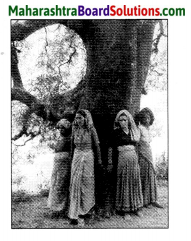
Answer:
(i) A show of constructive women power was seen during the Chipko Movement in 1973. The trees from the forests in the foothills of Himalayas were to be cut down for commercial purposes.
(ii) The important leaders of the Chipko Movement were: Chandiprasad Bhat, Sunderlal Bahuguna, Gaura Devi, Sudesha Devi and Bachani Devi.
Question 2.
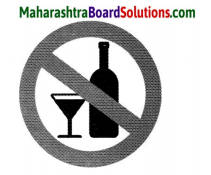
Answer:
(i) In 1992, in Andhra Pradesh a movement was started against the drinking of alcohol.
(ii) In 1992, three youths of Dubuganta village of Nellore district in Andhra Pradesh drowned in lake, in a state of inebriation and died. At this instance, the women of the village came together and forced the closure of arrack shops.
(iii) Arrack is a locally produced alcohol. As a result of a government policy arrack dealers set up shop in every town and village.
![]()
Question 3.
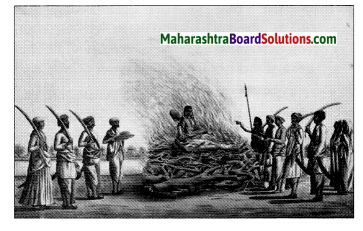
Answer:
(i) In 1998, the govt passed the Sati (Prevention) Act with very stringent provisions.
(ii) On 4th Sept. 1987, Roop Kanwar a married woman, committed sati. She did not do this of her own free will, she was coerced into doing so.
The women activists and journalists, Meena Menon, Geeta Seshu, Sujata Anandan, Anu Joseph and Kalpana Sharma investigated the case.
Question 4.
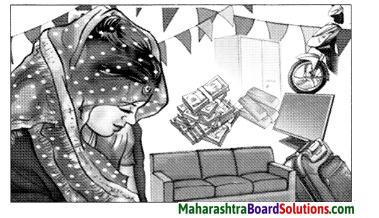
Answer:
(i) The Dowry Prohibition Act of 1961 made both giving and taking of dowry a cognizable criminal offence.
(ii) Even after the enactment of the anti-dowry law investigations still revealed dowry to be the most frequent cause of deaths. This created greater awareness. Thus, Dowry Prohibition (Amendment) Act came into force in 1984.